Dear Zazie, Here is today’s Lovers’ Chronicle from Mac Tag dedicated to his muse. Follow us on twitter @cowboycoleridge. Rhett
The Lovers’ Chronicle
Dear Muse,
© copyright 2021 mac tag/cowboy coleridge all rights reserved
they go on and on
essentially and absolutely
usin’, losin’, wantin’, denyin’,
avoidin’, adorin’, and replacin’
doin’, always doin’
refusin’, pleasin’,
betrayin’, and caressin’
tryin’ to hold
the ones that should be
and let go the rest
ridin’ on through
ever into
© copyright 2019 mac tag/cowboy coleridge all rights reserved
hour by hour keepin’ up a steady trot
sun sinks and the long shadows
lengthen down the prairie
movin’ veils of purple twilight
creep out of the hills,
soon merge and shade into night
guidin’ the pale horse nearer to the trail
to see better, ridin’ on through the hours
feel only vaguely, as outside things,
the ache and burn and throb of muscles
but the dammed-up torrent of emotion holds
and the hour for release, continues to elude
sufferin’, catchin’ glimpses into self,
into unlit darkness of soul
a torturin’ possession of mind
ranges, runs riotin’, tramplin’
resurgin’ hope, draggin’
ever into the hours
© copyright 2017 Mac tag/cowboy Coleridge all rights reservedly won
| Gertrude Stein | |
|---|---|
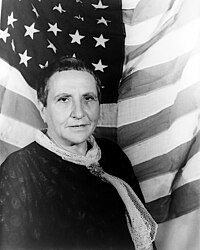
Stein in 1935 photographed by Carl Van Vechten
|
|
Today is the birthday of Gertrude Stein (Allegheny, Pennsylvania; February 3, 1874 – July 27, 1946 Neuilly-sur-Seine, France); novelist, poet, playwright, and art collector. Born in the Allegheny West neighborhood of Pittsburgh, Pennsylvania, and raised in Oakland, California, Stein moved to Paris in 1903, and made France her home for the remainder of her life. She hosted a Paris salon, where the leading figures of modernism in literature and art, such as Pablo Picasso, Ernest Hemingway, F. Scott Fitzgerald, Sinclair Lewis, Ezra Pound, and Henri Matisse would meet.
In 1933, Stein published a kind-of memoir of her Paris years, The Autobiography of Alice B. Toklas, written in the voice of her life partner, Alice B. Toklas, an American-born member of the Parisian avant-garde. The book became a literary bestseller and vaulted Stein from the relative obscurity of the cult-literature scene into the limelight of mainstream attention. Two quotes from her works have become widely known: “Rose is a rose is a rose is a rose” and “there is no there there“.
Her books include Q.E.D. (Quod Erat Demonstrandum) (1903), about a lesbian romantic affair involving several of Stein’s female friends; Fernhurst, a fictional story about a romantic affair; Three Lives (1905–06) and The Making of Americans (1902-1911). In Tender Buttons (1914), Stein commented on lesbian sexuality.
Stein met Toklas on September 8, 1907, on Toklas’s first day in Paris, at Sarah and Michael Stein’s apartment. On meeting Stein, Toklas wrote:
She was a golden brown presence, burned by the Tuscan sun and with a golden glint in her warm brown hair. She was dressed in a warm brown corduroy suit. She wore a large round coral brooch and when she talked, very little, or laughed, a good deal, I thought her voice came from this brooch. It was unlike anyone else’s voice—deep, full, velvety, like a great contralto’s, like two voices.
Quotes
“What is the answer?” [ I was silent ] “In that case, what is the question?”
- Last words (27 July 1946) as told by Alice B. Toklas in What Is Remembered (1963)
- Poetry is I say essentially a vocabulary just as prose is essentially not. And what is the vocabulary of which poetry absolutely is. It is a vocabulary based on the noun as prose is essentially and determinately and vigorously not based on the noun. Poetry is concerned with using with abusing, with losing with wanting with denying with avoiding with adoring with replacing the noun. It is doing that always doing that, doing that doing nothing but that. Poetry is doing nothing but using losing refusing and pleasing and betraying and caressing nouns. That is what poetry does, that is what poetry has to do no matter what kind of poetry it is. And there are a great many kinds of poetry. So that is poetry really loving the name of anything and that is not prose.
- “Poetry and Grammar”
- When I said. “A rose is a rose is a rose.” And then later made that into a ring I made poetry and what did I do? I caressed completely caressed and addressed a noun.
- “Poetry and Grammar”
One of the pleasant things those of us who write or paint do is to have the daily miracle. It does come.
Today is the birthday of Norman Percevel Rockwell (February 3, 1894 – November 8, 1978); painter and illustrator. His works have a broad popular appeal in the United States for their reflection of the country’s culture. Rockwell is most famous for the cover illustrations of everyday life he created for The Saturday Evening Post magazine over nearly five decades. Among the best-known of Rockwell’s works are the Willie Gillis series, Rosie the Riveter, The Problem We All Live With, Saying Grace, and the Four Freedoms series. He is also noted for his 64-year relationship with the Boy Scouts of America (BSA), during which he produced covers for their publication Boys’ Life, calendars, and other illustrations. These works include popular images that reflect the Scout Oath and Scout Law such as The Scoutmaster, A Scout Is Reverent and A Guiding Hand, among many others.
Gallery
And today is the birthday of Simone Weil (Paris; 3 February 1909 – 24 August 1943 Ashford, Kent, England); philosopher, mystic, and political activist.
| Simone Weil | |
|---|---|
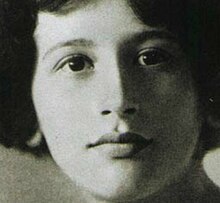
Weil in 1921
|
|
After her graduation from formal education, Weil became a teacher. She taught intermittently throughout the 1930s, taking several breaks due to poor health and to devote herself to political activism, work that would see her assisting in the trade union movement, taking the side of the Anarchists known as the Durruti Column in the Spanish Civil War, and spending more than a year working as a labourer, mostly in auto factories, so she could better understand the working class.
Taking a path that was unusual among twentieth-century left-leaning intellectuals, she became more religious and inclined towards mysticism as her life progressed. Weil wrote throughout her life, though most of her writings did not attract much attention until after her death. In the 1950s and 1960s, her work became famous on continental Europe and throughout the English-speaking world. Her thought has continued to be the subject of extensive scholarship across a wide range of fields. A meta study from the University of Calgary found that between 1995 and 2012 over 2,500 new scholarly works had been published about her. Albert Camus described her as “the only great spirit of our times“.
On Beauty
For Weil, beauty which is inherent in the form of the world. She saw it proven in geometry, and expressed in all good art. It is the proof that the world points to something beyond itself. It establishes the essentially telic character of all that exists. Beauty also served a soteriological function for Weil. It constitutes a way in which the divine reality behind the world infuses our lives. Where affliction conquers us with force, beauty steals in and topples the self from within. She wrote…
« l’art de tout premier ordre qui a nécessairement rapport à la sainteté. »
« Le beau est la preuve expérimentale que l’Incarnation est possible »
« Nous devons avoir la foi que l’univers est beau à tous les niveaux … et qu’il a une plénitude de la beauté par rapport au corps et à l’esprit des êtres pensants qui existent et de tous ceux qui pourraient exister. C’est un accord de l’infini d’une beauté parfaite qui donne un caractère transcendant à la beauté du monde … Il (le Christ) est réellement présent dans la beauté universelle. L’amour de cette beauté vient de Dieu, demeure dans nos âmes et retourne vers Dieu présent dans l’univers ».
« c’est le sourire de tendresse du Christ pour nous à travers la matière ».
« La beauté séduit la chair pour obtenir la permission de passer jusqu’à l’âme. »
Mac Tag

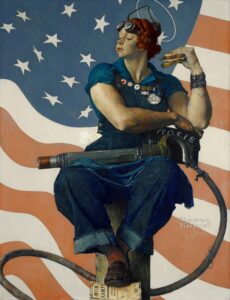
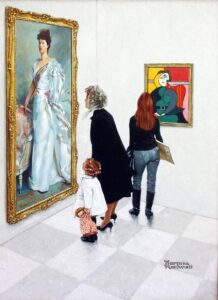
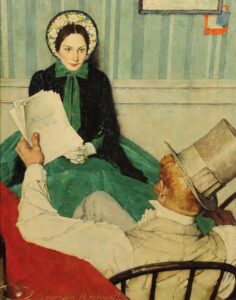
No Comments on "The Lovers’ Chronicle 3 February – hours – birth of Gertrude Stein & Simone Weil – art by Norman Rockwell"